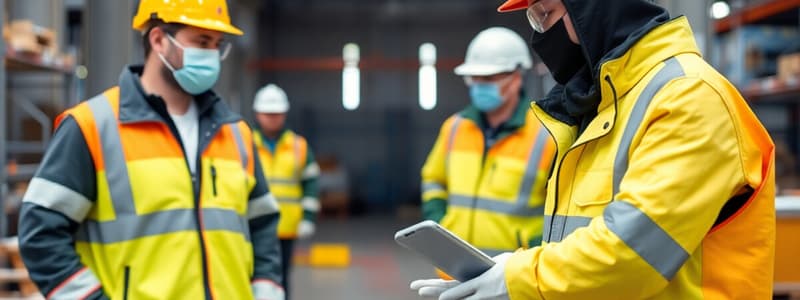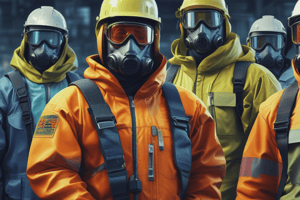Podcast
Questions and Answers
What is a common consequence of leaving tools and scrap material unattended in the workshop?
What is a common consequence of leaving tools and scrap material unattended in the workshop?
- Enhanced safety
- Encouragement of teamwork
- Sign of an unskilled worker (correct)
- Improved productivity
Which of the following activities can cause serious accidents in the workplace?
Which of the following activities can cause serious accidents in the workplace?
- Working quietly and efficiently
- Asking questions about safety
- Engaging in practical jokes (correct)
- Following safety regulations
What is a critical safety regulation regarding smoking in the workplace?
What is a critical safety regulation regarding smoking in the workplace?
- Smoking is only prohibited during lunch breaks
- Smoking is allowed in all areas
- Only certain materials can be smoked near
- Smoking can lead to explosive hazards (correct)
What should be done if electrical equipment appears to be in poor condition?
What should be done if electrical equipment appears to be in poor condition?
Why is it important to never remove guards from machinery?
Why is it important to never remove guards from machinery?
What should you do when lifting heavy weights?
What should you do when lifting heavy weights?
Why is electricity considered dangerous in the workplace?
Why is electricity considered dangerous in the workplace?
What is a primary disadvantage of green sand molds?
What is a primary disadvantage of green sand molds?
What material is commonly used for making patterns in mold production?
What material is commonly used for making patterns in mold production?
What do pattern allowances compensate for during the casting process?
What do pattern allowances compensate for during the casting process?
In the context of mold making, what is the purpose of a flask?
In the context of mold making, what is the purpose of a flask?
What is a characteristic of dry sand molds?
What is a characteristic of dry sand molds?
What are ferrous metals primarily characterized by?
What are ferrous metals primarily characterized by?
Which of the following is NOT a characteristic of non-metals?
Which of the following is NOT a characteristic of non-metals?
Which of the following materials is categorized under plastics?
Which of the following materials is categorized under plastics?
What property do metals generally exhibit that non-metals do not?
What property do metals generally exhibit that non-metals do not?
Which combination correctly describes the characteristic properties of metals?
Which combination correctly describes the characteristic properties of metals?
Which of the following materials is included in the natural non-metals category?
Which of the following materials is included in the natural non-metals category?
What distinguishes thermosetting plastics from thermoplastics?
What distinguishes thermosetting plastics from thermoplastics?
Which metal is known for its excellent malleability and ductility?
Which metal is known for its excellent malleability and ductility?
Why are non-metals typically described as insulators?
Why are non-metals typically described as insulators?
What is the primary use of lead based on its properties?
What is the primary use of lead based on its properties?
Which metal has the highest conductivity for electrical and electronic engineering?
Which metal has the highest conductivity for electrical and electronic engineering?
What is a common application for tin?
What is a common application for tin?
Which metal is known for its low tensile strength among the options?
Which metal is known for its low tensile strength among the options?
What is the role of zinc in the context provided?
What is the role of zinc in the context provided?
What property characterizes silver in the listed context?
What property characterizes silver in the listed context?
Which metal is used as an alloying element in bronzes?
Which metal is used as an alloying element in bronzes?
What is the tensile strength of lead as described?
What is the tensile strength of lead as described?
Which of the following metals is described as soft and ductile?
Which of the following metals is described as soft and ductile?
What is a primary characteristic of lead that makes it useful for specific applications?
What is a primary characteristic of lead that makes it useful for specific applications?
What does sensitivity refer to in measuring devices?
What does sensitivity refer to in measuring devices?
What is the significance of tolerance in manufacturing?
What is the significance of tolerance in manufacturing?
What affects the accuracy of measurements made with a rule?
What affects the accuracy of measurements made with a rule?
How should a rule be handled to ensure accurate measurements?
How should a rule be handled to ensure accurate measurements?
What is parallax error?
What is parallax error?
What should not be done with a good quality rule?
What should not be done with a good quality rule?
What is the typical thickness of a good measuring rule mentioned?
What is the typical thickness of a good measuring rule mentioned?
Why is it advisable to avoid rusting of the rule?
Why is it advisable to avoid rusting of the rule?
What do inside and outside calipers typically help with?
What do inside and outside calipers typically help with?
What is one key feature of a good quality rule?
What is one key feature of a good quality rule?
Flashcards
What are distracting behaviors in a workshop?
What are distracting behaviors in a workshop?
Actions that can distract workers, such as pushing, shouting, or practical joking. These behaviors can lead to serious accidents and create a negative work environment.
Why are workshop regulations important?
Why are workshop regulations important?
Always follow workplace regulations, even if they seem unnecessary. Rules are designed to protect workers and ensure safety.
Why should guards always be in place?
Why should guards always be in place?
Never remove safety guards from machinery. Guards are critical for preventing injuries during operation.
How should heavy lifting be done?
How should heavy lifting be done?
Signup and view all the flashcards
Why is electrical safety important?
Why is electrical safety important?
Signup and view all the flashcards
What are the risks associated with compressed air?
What are the risks associated with compressed air?
Signup and view all the flashcards
Why is workplace cleanliness important?
Why is workplace cleanliness important?
Signup and view all the flashcards
Engineering Materials
Engineering Materials
Signup and view all the flashcards
Ferrous Metals
Ferrous Metals
Signup and view all the flashcards
Non-ferrous Metals and Alloys
Non-ferrous Metals and Alloys
Signup and view all the flashcards
Non-metals
Non-metals
Signup and view all the flashcards
Malleable
Malleable
Signup and view all the flashcards
Ductile
Ductile
Signup and view all the flashcards
Alloys
Alloys
Signup and view all the flashcards
Good Conductors
Good Conductors
Signup and view all the flashcards
Insulators
Insulators
Signup and view all the flashcards
Electrical Conductor
Electrical Conductor
Signup and view all the flashcards
Lead
Lead
Signup and view all the flashcards
Silver
Silver
Signup and view all the flashcards
Tin
Tin
Signup and view all the flashcards
Zinc
Zinc
Signup and view all the flashcards
Heat Exchanger
Heat Exchanger
Signup and view all the flashcards
Bronze
Bronze
Signup and view all the flashcards
Brass
Brass
Signup and view all the flashcards
Tensile Strength
Tensile Strength
Signup and view all the flashcards
Sensitivity
Sensitivity
Signup and view all the flashcards
Readability
Readability
Signup and view all the flashcards
Precision
Precision
Signup and view all the flashcards
Accuracy
Accuracy
Signup and view all the flashcards
Tolerance
Tolerance
Signup and view all the flashcards
Nominal Size
Nominal Size
Signup and view all the flashcards
Total Tolerance
Total Tolerance
Signup and view all the flashcards
Calipers
Calipers
Signup and view all the flashcards
Parallax
Parallax
Signup and view all the flashcards
What is green sand mold?
What is green sand mold?
Signup and view all the flashcards
What is dry sand mold?
What is dry sand mold?
Signup and view all the flashcards
What is a skin-dried mold?
What is a skin-dried mold?
Signup and view all the flashcards
What is a flask in casting?
What is a flask in casting?
Signup and view all the flashcards
What is a pattern in casting?
What is a pattern in casting?
Signup and view all the flashcards
Study Notes
Chapter One: Safety
- Accidents are caused, not happen.
- Accidents can and must be prevented.
- Accidents cost significant lost man-hours and human suffering.
- The individual is usually the cause and casualty of accidents.
- Young workers are more prone to accidents due to inexperience.
1.2.1 Protective Clothing
- Overalls: Close-fitting, buttoned sleeves at the wrist, to avoid clothing getting caught in machinery.
- Shoes: Suitable shoes that can withstand the work environment to prevent injuries like puncture wounds or crushed toes.
- Goggles: Essential when grinding, chipping, or machining materials like brass, to protect the eyes.
- Gloves: Must be worn when handling raw materials like sheets, bars, castings to protect against injury by sharp edges.
1.2.2 Long Hair
- Long hair caught in machinery can lead to serious scalp injuries.
- Drilling, turning, and rotating machines are especially dangerous, with regard to hair.
1.2.3 Untidiness
- Obstructing gangways is dangerous and should be avoided.
- Spilled oil and water must be cleaned immediately.
- Tools and scrap material must not be left around.
1.2.4 Behaviors
- Distracting behaviors like pushing, shouting, or practical jokes can cause serious accidents.
- Good workshop etiquette is important.
1.2.5 Regulations
- Be aware of and obey safety regulations created by experienced workers.
- Don't ignore safety rules, and understand their purpose.
- Never tamper with electrical equipment without checking the condition with a qualified electrician.
1.2.6 Guards
- Use machinery only with the guards in place and functional.
- Removing guards is irresponsible and can lead to accidents.
1.2.7 Lifting
- Always use lifting tackles for heavy weights.
- Don't stand under the load when using lifting tackle.
1.2.8 Use & Maintenance of Hand Tools
- Use appropriate, correctly wired plugs for portable equipment, to prevent overheating and risk of fire.
- Secure all electrical connections.
- Use correct rating fuses (or electrical devices) to prevent faults such as shock or fire.
- Avoid makeshift fuses.
- Ensure good earthing of all external metal parts to ground incase of fault.
- Don't use damaged or worn electrical cables.
Studying That Suits You
Use AI to generate personalized quizzes and flashcards to suit your learning preferences.



